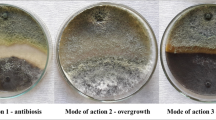Abstract
Secondary metabolites produced by the biocontrol fungi Trichoderma have been frequently implicated in the inhibition of diverse plant pathogens in several crops. We carried out laboratory and field studies to assess the antifungal potential of soluble inhibitory metabolites produced by Trichoderma against red rot of sugarcane caused by Colletotrichum falcatum. A total of 33 Trichoderma isolates were selected and assessed for production of soluble inhibitory metabolites against C. falcatum in vitro. Malt extract broth (MEB), potato dextrose broth (PDB) and minimal salts broth were evaluated as growth medium for production of inhibitory metabolites. For most isolates, the highest inhibitory activity was observed with metabolites produced on MEB and lowest when produced on PDB, indicating the importance of growth medium in inhibitory metabolite production. Considerable variability (ranging from 0.7 to 70.6 %) was observed in the inhibitory activity of soluble metabolites of the 33 isolates against C. falcatum with only five isolates showing >40 % inhibition in C. falcatum growth. Field experiments were carried out in two years to evaluate potential of Trichoderma metabolites for management of red rot. Sugarcane setts, pre-inoculated with C. falcatum, were treated with Trichoderma metabolites and planted. Observations on germination failure, settling, tiller and cane mortality due to red rot were recorded regularly. The metabolites of isolates STr-108 and STr-12 showed considerable reduction in red rot incidence (40–55 % reduction over control) in both years. The results indicate that direct application of these metabolites and/or development and application of biopesticides based on them has the potential to provide consistent and effective disease control.




Similar content being viewed by others
References
Bailey, B.A., H. Bae, M.D. Strem, J. Crozier, S.E. Thomas, G.J. Samuels, B.T. Vinyard, and K.A. Holmes. 2008. Antibiosis, mycoparasitism, and colonization success for endophytic Trichoderma isolates with biological control potential in Theobroma cacao. Biological Control 46: 24–35.
Calistru, C., M. McLean, and P. Berjak. 1997. In vitro studies on the potential for biological control of Aspergillus flavus and Fusarium moniliforme by Trichoderma species. Mycopathologia 137: 115–124.
Dubey, S.C., A. Tripathi, P. Dureja, and A. Grover. 2011. Characterization of secondary metabolites and enzymes produced by Trichoderma species and their efficacy against plant pathogenic fungi. Indian Journal of Agricultural Sciences 81: 455–461.
Duttamajumder S.K., and Misra S.C. 2014. Dynamics of red rot (Colletotrichum falcatum) development and spread in relation to sett-borne inoculum. In Proceedings of international conclave on sugar crops: sweeteners and green energy from sugar crops, p. 128. Lucknow: Emerging Technology, IISR. Feb. 15–17.
Duttamajumder, S.K. 2008. Red rot of sugarcane. Lucknow: Army Printing Press.
Elad, Y., I. Chet, and Y. Henis. 1981. A selective medium for improving quantitative isolation of Trichoderma species from soil. Phytopathology 9: 59–67.
Harman, G.E. 2011. Multifunctional fungal plant symbionts: new tools to enhance plant growth and productivity. New Phytologist 189: 647–649.
Joshi, Deeksha, and S.C. Misra. 2013. Characterization of Trichoderma isolates from sugarcane agro-ecosystem and their efficacy against Colletotrichum falcatum causing red rot of sugarcane. Sugar Tech 15: 192–196.
Lorito, M., C. Peterbauer, C.K. Hayes, and G.E. Harman. 1994. Synergistic interaction between fungal cell wall degrading enzymes and different antifungal compounds enhances inhibition of spore germination. Microbiology 140: 623–629.
Muthukumar, A., A. Eswaran, and K. Sanjeevkumar. 2011. Exploitation of Trichoderma species on the growth of Pythium aphanidermatum in Chilli. Brazilian Journal of Microbiology 42: 1598–1607.
Reino, J.L., R.F. Guerrero, R. Hernández-Galán, and I.G. Collado. 2008. Secondary metabolites from species of the biocontrol agent Trichoderma. Phytochemistry Reviews 7: 89–123.
Rini, C.R., and K.K. Sulochana. 2007. Usefulness of Trichoderma and Pseudomonas against Rhizoctonia solani and Fusarium oxysporum infecting tomato. Journal of Tropical Agriculture 45: 21–28.
Singh, V., B.B. Joshi, S.K. Awasthi, and S.N. Srivastava. 2008. Eco-friendly management of red rot disease of sugarcane with Trichoderma strains. Sugar Tech 10: 158–161.
Singh, V., R.J. Lal, S.K. Awasthi, and M.R. Verma. 2009. Managing red rot of sugarcane by Trichoderma harzianum. Indian Sugar 59: 25–30.
Srinivasan, U., H.J. Staines, and A. Bruce. 1992. Influence of media type on antagonistic modes of Trichoderma spp. against wood decay basidiomycetes. Materials and Organismen 27: 301–321.
Verma, M., S.K. Brar, R.D. Tyagi, R.Y. Surampalli, and J.R. Valero. 2007. Antagonistic fungi, Trichoderma spp.: panoply of biological control. Biochemical Engineering Journal 37: 1–20.
Vinale, F., K. Sivasithamparam, E.L. Ghisalberti, R. Marra, S.L. Woo, and M. Lorito. 2008. Trichoderma–plant–pathogen interactions. Soil Biology and Biochemistry 40: 1–10.
Vinale, F., R. Marra, R. Scala, E.L. Ghisalberti, M. Lorito, and K. Sivasithamparam. 2006. Major secondary metabolites produced by two commercial Trichoderma strains active against different phytopathogens. Letters in Applied Microbiology 43: 143–148.
Author information
Authors and Affiliations
Corresponding author
Ethics declarations
Conflict of interest
The authors declare that they have no conflict of interest.
Electronic supplementary material
Below is the link to the electronic supplementary material.
Rights and permissions
About this article
Cite this article
Joshi, D., Singh, P., Singh, A.K. et al. Antifungal Potential of Metabolites from Trichoderma sp. Against Colletotrichum falcatum Went Causing Red Rot of Sugarcane. Sugar Tech 18, 529–536 (2016). https://doi.org/10.1007/s12355-015-0421-y
Received:
Accepted:
Published:
Issue Date:
DOI: https://doi.org/10.1007/s12355-015-0421-y




